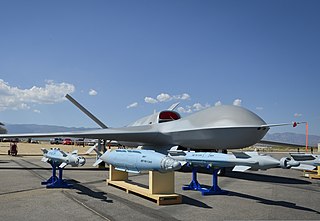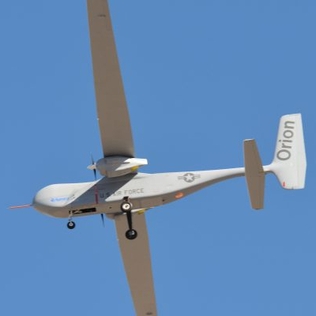
The General Atomics MQ-1C Gray Eagle is a medium-altitude, long-endurance (MALE) unmanned aircraft system (UAS). It was developed by General Atomics Aeronautical Systems (GA-ASI) for the United States Army as an upgrade of the General Atomics MQ-1 Predator.

The BAE Systems HERTI is an unmanned aerial vehicle (UAV) developed by the British company BAE Systems. HERTI stands for "High Endurance Rapid Technology Insertion" and was developed in Warton, United Kingdom. The HERTI airframe is based on the J-6 Fregata motor glider designed by Jaroslaw Janowski of J&AS Aero Design in Poland. Its first flight was in December 2004 at the Australian Woomera test range where much of the test flight programme has been undertaken. HERTI was also the first UAV to fly in the UK with the flight being certified by the Civil Aviation Authority.

The General Atomics MQ-20 Avenger is a developmental unmanned combat aerial vehicle built by General Atomics Aeronautical Systems for the U.S. military.

The Chengdu GJ-1, also known as Wing Loong 1, is a Medium-Altitude Long-Endurance (MALE) unmanned aerial vehicle (UAV), developed by the Chengdu Aircraft Industry Group in the People's Republic of China. Intended for use as a surveillance and aerial reconnaissance platform, the Pterodactyl I is capable of being fitted with air-to-surface weapons for use in an unmanned combat aerial vehicle (UCAV) role.
The BZK-005 Medium-altitude, long-range UAV is a reconnaissance aircraft designed by Beijing University of Aeronautics & Astronautics and Harbin Aircraft Industry (Group) Co., Ltd. It is used by the PLA Navy and PLA Air Force.

The HESA Hamaseh is an Iranian tactical and reconnaissance unmanned aerial vehicle (UAV) with high flight endurance built by Iran Aircraft Manufacturing Industrial Company (HESA). The Hamaseh was unveiled in 2013 and entered service in 2016.

CASC Rainbow is a series of unmanned aerial vehicles (UAVs) developed by the China Academy of Aerospace Aerodynamics, an entity under the China Aerospace Science and Technology Corporation (CASC). The China Academy of Aerospace Aerodynamics is also known as the 11th Academy of CASC or 701st Research Institute.
CASIC WJ is a series of unmanned aerial vehicles (UAVs) developed by the 3rd Academy Hiwing of the China Aerospace Science and Industry Corporation (CASIC), and the academy is also more commonly known as HiWING Mechanical and Electrical Technology Corp., or HiWING for short.

The Orion is a Medium-altitude long-endurance unmanned aerial vehicle (UAV) developed by Aurora Flight Sciences.

The Bell V-247 Vigilant is a concept by Bell Helicopter to develop a large tiltrotor unmanned aerial vehicle.

The Saegheh is an Iranian turbofan/piston-powered flying wing unmanned combat aerial vehicle (UCAV) produced by Shahed Aviation Industries. It is based on, but smaller than and substantially different from, a Lockheed Martin RQ-170 Sentinel UAV that was captured by Iran in 2011 and then reverse-engineered. It is one of two Iranian flying wing UAVs based on the RQ-170, along with the Shahed 171 Simorgh, a larger version.

The Wing Loong-10 is a series of unmanned aerial vehicles of the High-Altitude Long Endurance (HALE) type, featuring some stealth characteristics. As of 2017, it is being developed by the Chengdu Aircraft Industry Group for reconnaissance and precision strike missions.
Sichuan Tengden Technology, previously known as Tengoen Technology and Tengdun Technology is an privately-owned drone manufacturing company that specializes in the development and manufacturing of medium-to-large unmanned aerial systems for military and civilian applications.

The TAI Aksungur is an unmanned combat aerial vehicle (UCAV) built by Turkish Aerospace Industries (TAI) for the Turkish Armed Forces. Using existing technology from the TAI Anka series of drones, it is the manufacturer's largest drone with payload capacity for mission-specific equipment. It is intended to be used for long-term surveillance, signals intelligence, maritime patrol missions, or as an unmanned combat aerial vehicle. TAI planned to integrate weapon packages and put the Aksungur into production in early 2020. The first unit was delivered to the Turkish Naval Forces on 20 October 2021.

The Chengdu GJ-2, also known as Wing Loong 2, is an unmanned aerial vehicle (UAV) capable of remotely controlled or autonomous flight developed by the Chengdu Aircraft Industry Group in the People's Republic of China. Intended for use as a surveillance and aerial reconnaissance and precision strike platform, Chengdu unveiled the concept of Wing Loong II at the Aviation Expo China in Beijing in September 2015. Wing Loong II has long range strike capability with a satellite link.

The Mohajer-6 is an Iranian single-engine multirole ISTAR UAV capable of carrying a multispectral surveillance payload and/or up to four precision-guided munitions.
The Shahpar ll is an unmanned combat aerial vehicle (UCAV) built by Global Industrial Defence Solutions of Pakistan. It is currently in production following the completion of a test and qualification phase.

The Shahed 149 Gaza or, is an Iranian unmanned combat aerial vehicle (UCAV) operated by the Iranian Revolutionary Guard. It was unveiled on 21 May 2021 and named after the Gaza Strip in honor of the Palestinians' struggle against Israel amid the 2021 Israel–Palestine crisis. It was delivered to the IRGC Aerospace Force in 2022.
The General Atomics Mojave is an unmanned aerial vehicle (UAV) capable of short takeoff and landing (STOL), being developed by General Atomics Aeronautical Systems. First unveiled on December 9, 2021, General Atomics states that it is to fulfill the roles of reconnaissance, close air support and armed overwatch.

The Baykar Bayraktar TB3 is a Turkish medium-altitude long-endurance (MALE) unmanned combat aerial vehicle (UCAV) capable of short-range landing and take-off, produced by Baykar. It is currently being developed due to the lack of aircraft to be deployed on the TCG Anadolu amphibious assault ship. According to the initial plans the ship was expected to be equipped with Lockheed Martin F-35B Lightning II fighter jets but following the removal of Turkey from the procurement program, the vessel entered a modification process to allow it to be able to accommodate UAVs.















